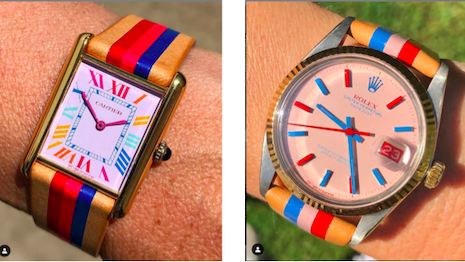- About
- Subscribe Now
- New York,
February 7, 2020

 La Californienne-altered Rolex and Cartier watches
La Californienne-altered Rolex and Cartier watches
What is a counterfeit?
Usually the answer is simple: an item made by somebody not authorized by the trademark owner, and which has an identical or virtually identical copy of the trademark on it.
For example, if someone not Gucci – nor authorized by Gucci – produces a handbag and slaps the Gucci brand on it, that is a counterfeit. If Gucci puts Gucci on a handbag, it is not.
But a recent Rolex case brought against a company named La Californienne highlights another kind of counterfeit.
Authentic goods that are altered can, depending on how extensively they are altered, turn into what the law considers counterfeits. That is what Rolex is claiming – and a long line of cases supports its position.
La Californienne case
La Californienne’s Web site claims that it “restores vintage timepieces and reimagine them in bold color.” It takes old luxury brand watches, mainly Rolex and Cartier, refinishes and repaints them, and then offers them for sale to the public. The result is a watch far bolder than the original:
La Californienne makes significant alterations to achieve its product. It replaces the watch crystals, refashions the bezels, and strips and repaints the watch faces and straps.
These alterations can cause problems.
Rolex alleges that in the sample watch it purchased, the bezel was bent and did not properly fit the watch, which would likely lead to leaking and then malfunctioning of the watch.
The altered watches still prominently bear the original Rolex trademarks. They do also bear La Californienne’s mark, but only in small print at the bottom of the dial.
Such alterations often void the manufacturer’s warranty and any post-sale service.
Rolex’s complaint notes that one such watch was submitted for service, but was returned because Rolex no longer considers the watch genuine and refuses to service it.
So, are they counterfeit?
But are the watches that La Californienne is selling counterfeit?
The answer, perhaps surprising to the layman, is: yes.
To understand why this is the case you have to go through some legal history.
In 1947, the United States Supreme Court considered a case involving the resale of refurbished Champion sparkplugs. Champion objected – it did not want its mark used on a product it did not make and did not have a hand in refurbishing.
The Supreme Court, however, rejected that argument. So long as it was made clear to the buyer that the items were refurbished – which meant it had to be stamped right on the spark plug – then there was no reason why the refurbisher could not resell the product.
But the court went on to say, “[c]ases may be imagined where the reconditioning or repair would be so extensive or so basic that it would be a misnomer to call the article by its original name, even though the words ‘used’ or ‘repaired’ were added.”
It did not take long for luxury watch companies to “imagine” such cases.
A series of legal suits, several brought by Rolex, held that because certain components of a watch – a case, a dial, a bezel, a strap – are so basic to its function, replacing them with a non-genuine part renders the whole watch inauthentic. And, since the watch still bears the exact same trademark, counterfeit.
So, these cases held that if someone replaces the dial on a Rolex watch with his own dial, then the new watch is no longer a genuine Rolex. Reselling it with the Rolex mark on it is counterfeiting.
Rolex is not the only one to have made such claims.
The author represented Cartier in a series of cases brought against jewelers who added diamonds to Cartier watches and then resold them. Again, in all of these cases, the courts held that these altered watches were no longer a genuine Cartier product, and hence counterfeit.
This seems to be Rolex’s primary theory in the La Californienne case.
The alterations are so basic that the watches are no longer properly treated as genuine Rolex watches.
Aesthetic changes
Rolex also asserts another interesting theory: “Defendants’ altered watches no longer attain the aesthetic of original pre-owned Rolex watches.”
In the luxury goods market, brand image is, of course, crucial, and a brand’s aesthetic has a major impact on that image.
Apart from the functional quality of its products, a brand wants to control the aesthetic aspect of its product line.
Rolex will argue that the changes to the aesthetics of the watches sold by La Californienne are “so basic that it would be a misnomer to call the article by its original name.”
Anyone familiar with Rolex’s product line who looks at a La Californienne will instantly see that they are a major deviation. Whether that convinces the court remains to be seen.
Post-sale confusion
But wait, you say.
In a prior article on trademark law (see story), I wrote that “likelihood of confusion” is the bedrock test for trademark infringement.
If no one is confused, there is no legal claim, even if the trademark is exactly the same.
La Californienne’s Web site gives full disclosure of what it is doing – taking used (or “vintage”) watches, refurbishing and repainting them, and then reselling them. That full disclosure arguably means that its customers are not confused or deceived in any way.
That, in fact, was the basis of the Supreme Court’s decision in the Champion spark plug case – there was full disclosure that the item was used and refurbished. The customer knew what he got. No confusion, no trademark infringement.
So why does Rolex have a case?
Enter the concept of “post-sale confusion.”
This legal doctrine was conceived by courts in cases involving cheap counterfeits. Someone who buys a $15 “Louis Vuitton” handbag on a street corner has no reasonable belief that he or she is getting an original. And the law does not protect from that kind of confusion.
But the person buying such a counterfeit woman’s handbag would be expected to carry it to impress her friends and people she meets. Those onlookers could well be misled into thinking the item is genuine. And, if the item has poor workmanship or a shoddy appearance, then the onlookers will blame that on the manufacturer, not knowing that they are viewing a counterfeit.
Post-sale confusion also protects against another interest of trademark owners.
Many companies, especially in the luxury goods field, cultivate an image of exclusivity and affluence. That can be hurt when cheap counterfeits flood the market.
If the proverbial “every Tom, Dick and Harry” carry your brand, then upscale customers may well not want to buy it.
So, courts recognize the theory of post-sale confusion – someone sees the item being worn or carried post-sale and is confused into believing the item is real. That resulting confusion qualifies the use of the mark as trademark infringement.
This fits well with Rolex’s claim in the La Californienne.
The Rolex marks – Rolex, the crown and other marks – appear very prominently, while La Californienne is barely visible at the bottom. Someone seeing that would likely think it a Rolex – and that is where post-sale confusion comes into play.
* * *
TRADEMARKS PROTECT a company’s reputation and goodwill.
Generally, the rights a company has in its mark ends when it sells the product. A customer can do what she likes – resell it or alter it.
But when used or altered products are resold, especially when a company makes a business of reselling such products, then the reputation of the original trademark owner is being used to sell the item. A used or altered Rolex is still a Rolex.
Items that are fundamentally altered are no longer the product of the original manufacturer.
Rolex’s complaint, put simply, is that the altered watches are not its product – it has no control over their quality and aesthetic. But, because of its name on the product, it will be blamed for any perceived quality issues.
So, although somewhat surprising, what was a genuine Rolex watch can become a counterfeit. La Californienne is likely to learn that in the near future.
Disclosure: Mr. Springut's law firm has represented Cartier in similar cases where jewelers added diamonds to Cartier watches and then resold them. Cartier objected and the courts held them as counterfeits.
 Milton Springut is a partner at Springut Law PC
Milton Springut is a partner at Springut Law PC
Milton Springut is a partner at Springut Law PC, New York. Reach him at ms@springutlaw.com. Mr. Springut's opinions are solely his.
Share your thoughts. Click here